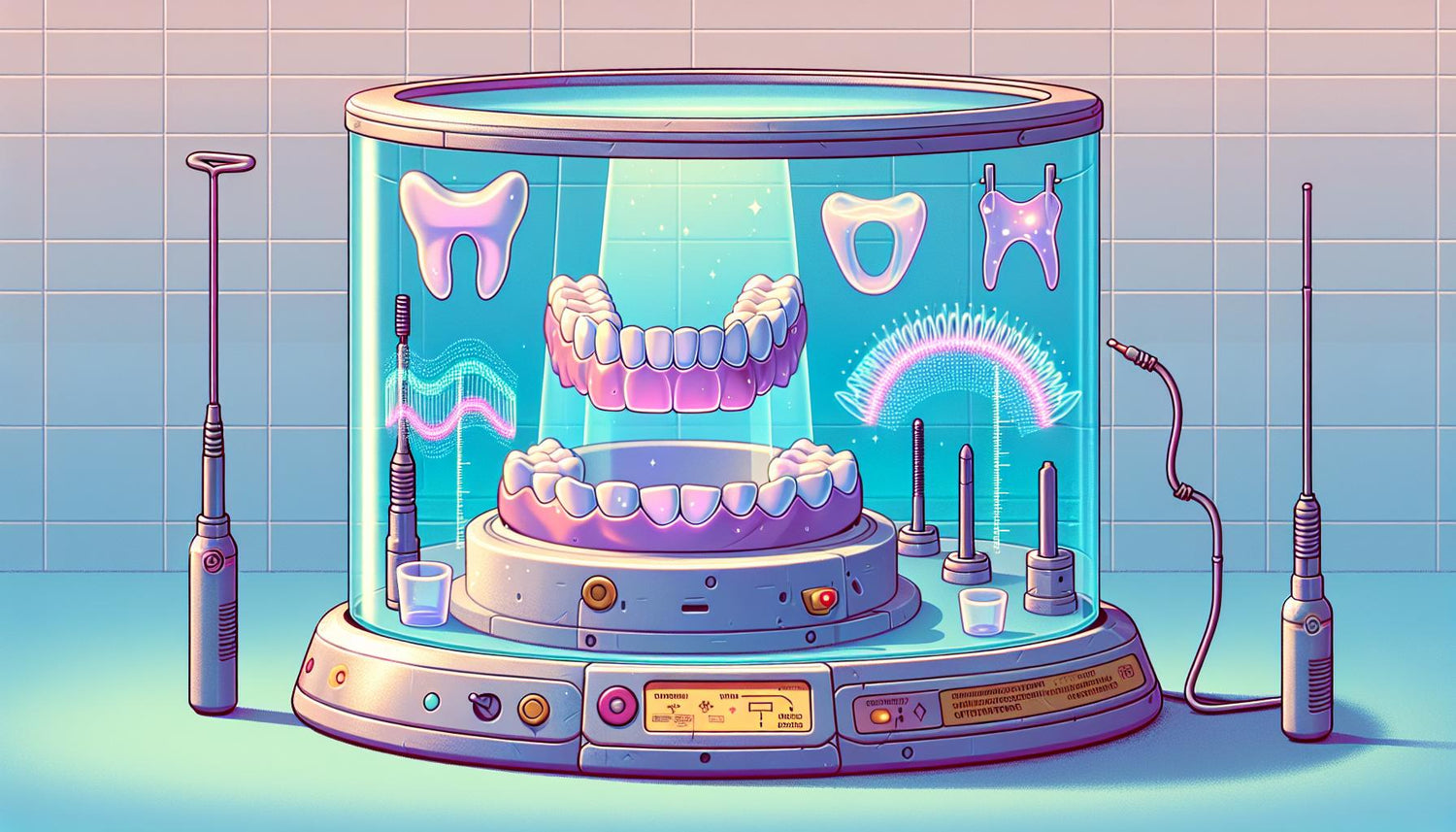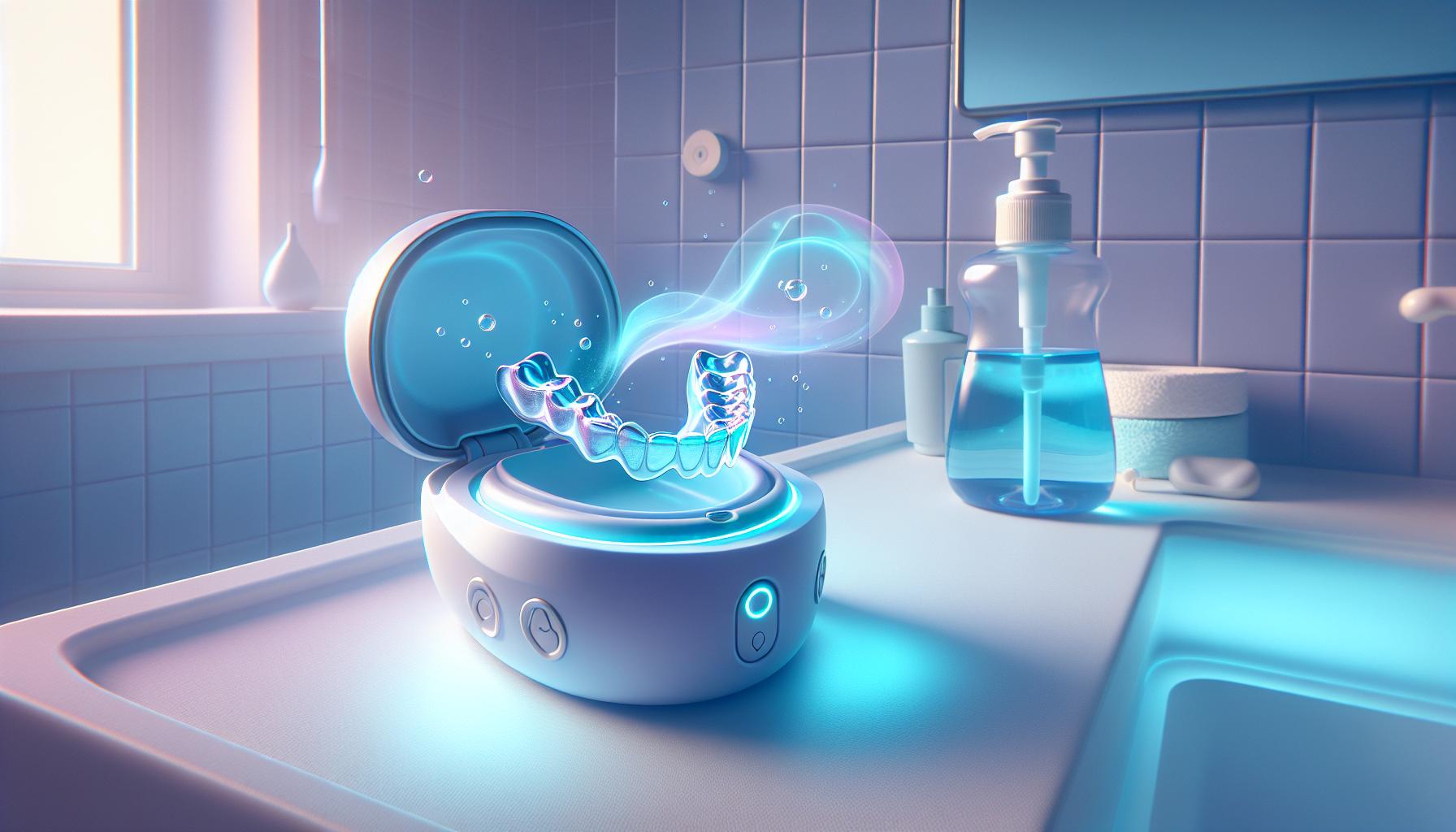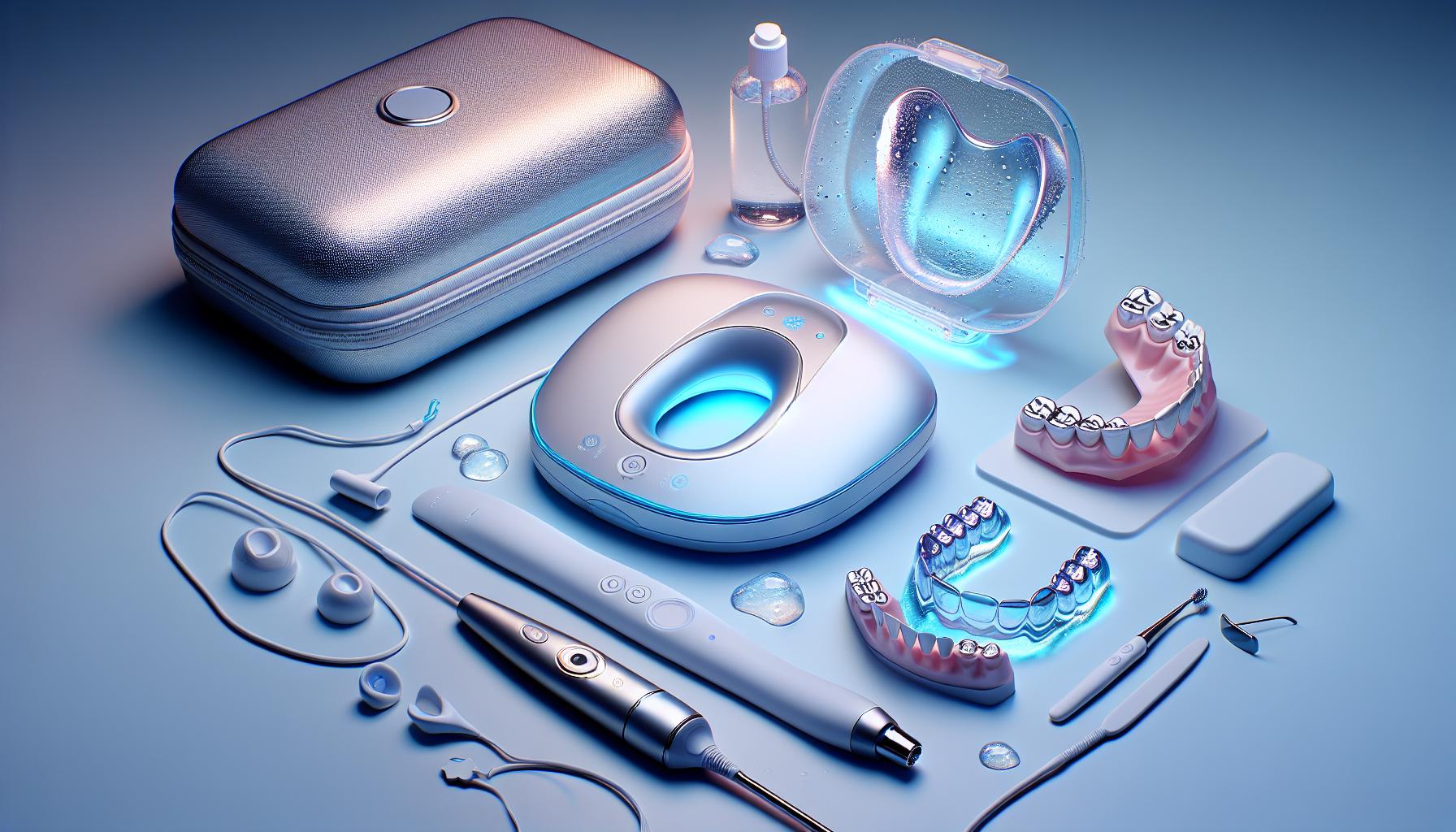Table of Contents
- Understanding Retainer Hygiene and Contamination
- How Do UV Lights Work for Retainer Cleaning?
- The Limitations of UV Light Cleaning
- The Science Behind Ultrasonic Cleaning Technology
- Why Choose an Ultrasonic Retainer Cleaner?
- Choosing the Best Cleaning Device for Your Appliance
- Comparing UV Light and Ultrasonic Cleaning Methods
- Real-World Applications: Invisalign and Denture Cleaning
- Tips for Enhancing Your Retainer Cleaning Routine
- Conclusion: The Future of Retainer and Oral Appliance Care
Understanding Retainer Hygiene and Contamination
Retainers, dental aligners, and dentures are daily companions for millions of people. Unlike everyday items, these appliances reside in a moist environment that can harbor bacteria, plaque, and biofilm. Over time, accumulation of these contaminants not only affects oral health but can also lead to unpleasant odors or discolorations.
Regular cleaning is essential. While brushing and soaking are common methods, modern technology has introduced a variety of specialized cleaning devices aimed at delivering more effective and less labor-intensive results.
With concerns about all-day exposure to bacteria, many are turning to high-tech solutions to maintain optimal oral hygiene. Let’s explore two prevalent methods: UV light cleaning and ultrasonic cleaning.
How Do UV Lights Work for Retainer Cleaning?
UV light cleaning technology is based on the use of ultraviolet rays that can destroy microbial DNA and RNA. When these rays strike bacteria and viruses, they cause chemical changes to the organism's genetic material, effectively neutralizing them and preventing their replication.
The Science Behind UV Disinfection
- Germicidal UV-C Light: UV-C light, in particular, has been highlighted for its disinfection properties. When applied to a retainer surface, UV-C light can reach crevices and irregular surfaces, theoretically deactivating potentially harmful microbes.
- Duration of Exposure: The bactericidal effect of UV light is dependent on the intensity of the light and the duration of exposure. Short bursts may not fully disinfect every nook of a retainer.
- Non-Chemical Alternative: UV cleaning offers a non-chemical cleaning method, which is attractive for individuals concerned about residual cleaning agents affecting their appliances.
Despite these points, while UV lights have a proven track record in sterilizing air, water, and surfaces in many scientific applications, their efficacy in cleaning dental appliances like retainers might not be as robust on all fronts.
The Limitations of UV Light Cleaning
Though UV light cleaning has its merits, there are notable challenges when it comes to thoroughly sanitizing retainers:
- Shadowed Areas: Retainers often have complex geometries and intricate designs. UV light cleaning may struggle to reach deeper grooves and shadowed areas, leaving behind potential bacterial hotspots.
- Surface Residue: Even when microbes are deactivated, debris, plaque, and tartar buildup may not be removed solely by UV exposure. These residues can shield bacteria from future cleaning efforts.
- Maintenance and Safety: UV devices require regular bulb replacement, and direct exposure to UV light can be hazardous if not properly managed.
- Limited Penetration: UV rays are most effective on directly illuminated surfaces. Any obstruction, such as a slight misalignment or covering by a biofilm layer, can reduce the disinfecting efficacy.
Due to these limitations, many dental professionals and tech-savvy consumers are exploring alternatives to UV cleaning. One such method is using an ultrasonic retainer cleaner.
The Science Behind Ultrasonic Cleaning Technology
Ultrasonic cleaning is a technology that uses high-frequency sound waves to generate microscopic bubbles in a liquid cleaning solution. When these bubbles collapse—a process called cavitation—they create tiny, high-energy shock waves that dislodge dirt, debris, and microbial contaminants from surfaces.
How Ultrasonic Cleaning Works:
- Cavitation Process: The ultrasonic waves passing through the cleaning solution produce millions of nano-sized bubbles. Upon collapsing, these bubbles generate a scrubbing action that reaches small crevices and complex surfaces.
- Deep Penetration: The cleaning effect is not limited by line-of-sight issues. Instead, the ultrasonic waves propagate through the liquid, cleaning every exposed part of the retainer or dental appliance.
- Time-Efficient: Typically, ultrasonic retainer cleaners require only a few minutes per cleaning cycle, offering a quick yet thorough alternative.
- Chemical Complement: Ultrasonic cleaners can be combined with specially formulated solutions that help break down protein films and biofilms, providing a multi-faceted cleaning approach.
These properties make the ultrasonic retainer cleaner a highly effective tool in modern dental appliance hygiene routines.
Why Choose an Ultrasonic Retainer Cleaner?
Changing traditional cleaning methods can be a game-changer. Here’s why an ultrasonic retainer cleaner might be the superior choice for many:
Precision and Efficiency
An ultrasonic cleaning device is engineered to work on delicate appliances. Whether you’re using it for your retainer, an ultra sonic cleaner for retainer options, or even an ultrasonic invisalign cleaner, its mechanism is gentle yet powerful enough to clean without damaging the structure.
Versatility in Use
Ultrasonic cleaning machines are not limited to retainers. They work equally well for:
- Invisalign Aligners: These devices often have intricate designs that benefit from an ultrasonic invisalign cleaner, which can clean both the surface and internal grooves.
- Dentures: Cleaning dentures with ultrasonic cleaner technology has become popular because it ensures thorough removal of food particles and bacterial plaque, enhancing both hygiene and longevity.
- Jewelry and Small Devices: Their capability to clean delicate items has made ultrasonic cleaners a staple for precision cleaning in various industries.
User-Friendly Technology
Modern retainer cleaner machines are designed with user experience in mind. Many come with preset cycles, safety locks, and clear instructions, making them suitable for individuals of all ages who wish to maintain their personal oral hygiene with minimal hassle.
Time and Resource Efficiency
Because ultrasonic cleaning cycles are short, they save precious time compared to manual scrubbing. Additionally, the process is less likely to wear out the retainer compared to traditional mechanical cleaning or harsh chemical treatments.
Combining efficiency and effectiveness, many consider the best ultrasonic retainer cleaner to be a must-have for maintaining the health and longevity of dental appliances.
Choosing the Best Cleaning Device for Your Appliance
Selecting a cleaning device that fits your needs can be complex, but knowing what features to look for can help guide your decision. Here are some key factors to consider:
1. Device Compatibility
- Ultrasonic Retainer Cleaner & Ultra Sonic Cleaner for Retainer: Ensure the machine is designed to clean dental appliances. Some models may also be promoted as ultrasonic invisalign cleaner machines, which means they are tailored for use with clear aligners and similar appliances.
- Retainer Cleaner Machine Versatility: Some devices can also clean dentures and even jewelry. Consider multifunctionality if you plan to clean various items.
2. Cleaning Cycle and Duration
- Short and Efficient Cycles: Look for machines that offer multiple cycle options. Some of the best retainer cleaner machines provide customizable cleaning durations to match the level of contamination.
- Energy Efficiency: Devices that can clean effectively without wasting energy are preferable both for regular use and long-term savings.
3. Ease of Use and Maintenance
- Simplicity: Devices designed with straightforward controls, clear displays, and minimal maintenance needs will reduce any learning curve.
- Ease of Cleaning the Machine: It’s important that the device itself is easy to maintain, with removable trays or chambers that can be rinsed or wiped down.
4. Price and Warranty
- Value for Money: When comparing products such as the best ultrasonic retainer cleaner and the best retainer cleaner machine, balance the features, durability, and customer reviews.
- Warranty and Customer Support: A good warranty period and reliable customer support indicate that the manufacturer stands behind the product.
5. Safety Features
- Child Safety Locks: Some models come with safety locks and automatic shutoff features. These ensure that if a child accidentally turns on the device, the machine will operate safely.
- Certification: Check if the device is certified by relevant health or product safety organizations, ensuring it meets rigorous standards.
By considering these factors, you can select a cleaning technology that not only maintains oral hygiene but also enhances the durability of your dental appliances.
Comparing UV Light and Ultrasonic Cleaning Methods
To summarize the differences between UV light cleaning and ultrasonic cleaning, here’s a comparative overview:
| Feature | UV Light Cleaning | Ultrasonic Cleaning |
|---|---|---|
| Mechanism of Action | Uses ultraviolet rays to damage microbial DNA | Uses high-frequency sound waves to create cavitation |
| Coverage | Limited effectiveness in shadowed areas | Deep penetration in every crevice and surface |
| Residue Removal | May not remove physical debris and plaque | Effectively dislodges debris along with microbes |
| Cleaning Cycle Duration | Longer exposure needed for full disinfection | Typically a few minutes per cycle |
| Maintenance | Bulb replacement and safety precautions needed | Lower maintenance with fewer moving parts |
| Versatility | Primarily disinfects surfaces | Suitable for retainers, Invisalign, dentures, jewelry, etc. |
| Safety | Risk of accidental exposure to harmful rays | Generally safe when used as directed |
Both technologies have their place in cleaning routines. However, for a comprehensive cleaning solution that covers both disinfection and physical debris removal, the ultrasonic cleaning method markedly outperforms UV light cleaning.
Real-World Applications: Invisalign and Denture Cleaning
Ultrasonic Invisalign Cleaner
Invisalign aligners, similar to retainers, have complex shapes and multiple edges that can accumulate bacteria. An ultrasonic invisalign cleaner:
- Ensures All-Around Cleaning: The cavitation process reaches every nook of the aligner, ensuring that microbes trapped in crevices are effectively removed.
- Prolongs Appliance Life: Regular ultrasonic cleaning prevents build-up that might otherwise degrade the appliance material over time.
- Enhances Oral Health: By reducing the potential for bacterial growth, it minimizes the risk of oral infections and bad breath.
Cleaning Dentures With Ultrasonic Cleaner
Dentures, which are subject to continuous exposure to food particles and saliva, benefit significantly from ultrasonic cleaning:
- Thorough Debridement: The ultrasonic cleaning method powerfully dislodges food debris and plaque, ensuring a cleaner and healthier appliance.
- Improved Fit and Comfort: Regular cleaning helps maintain the denture’s fit, reducing irritation and discomfort caused by microbial accumulation.
- Multi-Use Device: Many retainer cleaner machines double as devices for cleaning dentures, representing a cost-effective solution for comprehensive dental appliance care.
Tips for Enhancing Your Retainer Cleaning Routine
- Daily Cleaning: Incorporate a daily cleaning regimen for your retainer or aligners. Even if you use an ultrasonic retainer cleaner several times a week, a quick rinse in the morning and evening can help remove superficial buildup.
- Regular Deep Cleaning Cycles: Set aside time for a weekly deep cleaning session using an ultra sonic cleaner for retainer, ensuring thorough removal of any stubborn residues.
- Avoid Harsh Chemicals: Instead of relying on harsh chemical cleaners, opt for solutions recommended by dental professionals. Combined with an ultrasonic cleaning machine, these solutions can safely break down proteins and biofilms.
- Check Device Functionality: Regularly inspect your cleaning device to ensure that it is operating correctly—look for signs of wear, water residue in undesired places, or device malfunctions.
- Follow Manufacturer Guidelines: Every device, whether it’s labeled as the best ultrasonic retainer cleaner or the best retainer cleaner machine, comes with a set of instructions. Adhering to these ensures both longevity and optimal cleaning performance.
- Store Appliances Safely: After every cleaning cycle, dry your appliance thoroughly and store it in a clean container to prevent re-contamination.
Conclusion: The Future of Retainer and Oral Appliance Care
As technology evolves, so too do our methods for maintaining dental appliance hygiene. While UV lights offer a chemical-free disinfection method, their limitations in reaching every crevice and removing physical debris make them a less-than-complete solution for retainers, Invisalign aligners, and dentures.
Ultrasonic cleaning technology, on the other hand, leverages the science of cavitation to provide a comprehensive cleaning process. The ultrasonic retainer cleaner, along with specialized ultra sonic cleaner for retainer devices, presents a compelling alternative that not only disinfects but also thoroughly removes debris and plaque. With models available that cater to various dental appliances—from the best ultrasonic retainer cleaner to versatile retainer cleaner machines that clean dentures and Invisalign aligners—this technology is paving the way for a safer, more efficient future in oral hygiene.
Choosing the right cleaning device ultimately depends on your individual needs, the complexity of your dental appliance, and your routine preferences. By understanding the science behind UV light disinfection and comparing it with the robust capabilities of ultrasonic cleaning, you can make an informed choice that benefits your overall oral health.
As more people recognize the benefits of ultrasonic cleaning, the market is likely to see further innovation and improvements. Whether you’re looking for an ultrasonic invisalign cleaner, a retainer cleaner machine, or researching cleaning dentures with ultrasonic cleaner, the shift towards ultrasonic technology reflects a broader trend: a commitment to precision, efficiency, and comprehensive care in our daily lives.
Embrace the future of retainer cleaning by exploring these advanced technologies, and enjoy peace of mind knowing that your oral appliances are maintained in the safest and most effective way possible.
By incorporating advanced technologies into your cleaning routine and understanding the science behind them, you ensure not only a cleaner retainer but also a healthier, happier smile every day. Happy cleaning!
Have more questions about ultrasonic cleaning methods or need help selecting the right device for your needs? Feel free to leave a comment or reach out for professional recommendations.


